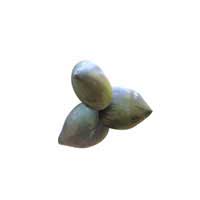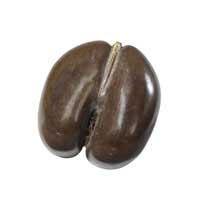 Full List of Fruits
Full List of Fruits  Double Coconut
Double CoconutDouble Coconut
![]() Introduction of Double Coconut
Introduction of Double Coconut
Scientific name - Lodoicea maldivica
Scientifically known as Lodoicea, double coconut belongs to the palm family. The name has it, it is very similar to that of a normal coconut but it is one of the most rarely found and also most sought after fruits in the world. This tree gets its name from its appearance, the coconut. Apart from being known as double coconut, this tree is popular amongst the locals by the names of Coco De Mer or even the Sea coconut. Being the rarest of its kind this fruit can only be found in the islands of Seychelles namely Praslin and Curieuse. One may begin to wonder what is so rare about a coconut, well the double coconut is endemic. Endemic plants are the ones that can only be found in one particular climatic zone, region or a specific geographical location. Tracing their natural existence apart from their natural place of habitat is a waste of attempt. Formerly these tress were also found on the small islets of St Pierre, Chauve-Souris and Ile Ronde (Round Island) all located near Praslin Island, but due to increase in deforestation and human population the gradually faded away and became extinct in those islets.
This fruit falls under the monotypic category. Meaning, this category or division has no sub division or branches. The species of the plant has no sub species to it
What's in the name?
The name of the fruit honors King Louis XV of France, a remarkable king that was worshipped by this people. The genus that the fruit belongs to is known as Lodoicea, which is actually derived from the word Lodoicus that translates to the Latin version of the name Loius. Thus honoring the Great king of France.
![]() Physical appearance of the Double Coconut
Physical appearance of the Double Coconut
Double coconut unlike the usual coconut is a massive fruit and more over it is also known as the largest fruit in the world. Just like other palms this tree also grows tall up to 25- 34 meters tall. The tree bears fan shaped leaves that are 7-10 meters long and are wide spread up to 4.5 m in width. The slender petiole that joins the leaves to the bark of the tree are 4 meters wide.
Being a dioecious plant this tree bears two separate male and female parts. The male flowers of this plant holds resemblance to that of a spike furry catkin which grows upto 1 meter long. On maturing the fruit starts to weigh 15- 30kgs and grows up to 40- 50 cm in diameter. This fruit becomes the bearer of the world's largest seed ever seen in the plant kingdom. This is a slow growing tree and the fruit takes about a period of 6-7 years to mature fully. Apart from that it takes another two years to germinate.
A double coconut tree is similar to all the other palm tree belonging to the monodominant forest. Am monodominant forest is the one that where 60% of the forest is covered with canopy trees. These are mostly humid tropical forest. To add on to the list of unique features of this tree double coconut have a massive and a gigantic seed inside the fruit, it also has a very effective operative funneling mechanism that comes to action when you have two water bearing nuts in one. To propagate the dispersion of seeds and to ensure natural growth of the plant it is dependent on a community of closely related animals that enables the entire process.
One of the least known fact is that the islands of Seychelles are synonymous to gigantism, this island holds the record for producing the largest fruit that mankind has ever seen, a record of mature seed weighing upto 17.6 kgs making it the world's heaviest and also bearing the largest female flowers ever witnessed in any palm.
There are totally six endemic palms in total that are recorded out of which double coconut is the only dioecious plant that bares male and female flowers on different plants.
As discussed earlier these trees are endemic in nature and are found mostly in monotypic regions where they tend to form a canopy. A unique feature about this plant is that it can actually thrive in any kind of soil type, having said that these trees have restricted their existence to hill slopes and valleys. The ideal place to see the best results are in forest on deep valley soils that do not accumulate water enabling good drainage. They can be seen co existing with other palms like Deckenianobilis and screw pines Pandanushornei.
Their growth can be hindered by some factors such as lack of light penetration due to thick canapoy formation and another factor being thick leaf litter. Other plants like the epiphytes such as lichen can be spotted living in tiny crevices in the bark of the tree. Epiphytes are the category of plant that grow on other plants but independently. They do not survive on the host plants nutrition unlike parasitic plants. They survive on their own by getting moisture from the air along with its nutrients from the sunlight. Ferns can also be seen growing on the crown of the flower arrangement of the tree.
The flora and fauna on the island of Seychelles share a very complex relationship that is hard to crack. The endemic species of birds and animals namely the Black Parrot (Coracopsisnigrabarklyi) the Seychelles Bulbul (Hypsipetescrassirostris), and three Gecko species, Phelsumasunbergi, Phelsumaasiatica and Ailuronyxsechellensis. Adding on to the list are the Seychelles snails, Pachnoduspraslinus, is also found in Lodoicea forest. Their contribution towards the existence of these plants is yet to be discovered.
![]() Nutritional Value of Double Coconut
Nutritional Value of Double Coconut
| Serving Size | Amount per Serving |
| Calories 359 | Calories from Fat 198 |
| % Daily Value* | |
| Total Fat 22g | 34% |
| Sugar Alcohols | 0g |
| Cholesterol 0mg | 0mg |
| Total Carbohydrates 33g | 11% |
| Protein | 6g |
| Other Nutrients | |
| Food Score | 0.9 |
| Net Carbohydrates | 33g |
| Diabetes Carb Count | 33g |
Apart from being known for its gigantic fruit double coconut has various other utilities attached to it. Back in old times this plant was used for its medicinal properties that helped in wading off many life threatening diseases. The long leaves were big enough to be used in making huts and thatches for roofs. The shells of the fruit served as utensils and storage containers to store water and other essentials in them. The dried remains of the tree served purposefully as a stuffing for pillows. Owing to the magnificence the shell of the fruit holds it is often treated and traded as a souvenir or also adorns the walls of many as a decorative item.
The real purpose of the fruit, the edible part is the endosperm of the fruit that is succulent and a delight to the taste buds. In case of the immature seeds they tend to contain a jelly like substance that melts in the mouth with a sweet taste. This is treated as a delicacy and is enjoyed by the locals.
The endocarps of the larger fruits are utilized as bowls, plates and water drinking tumblers. The leaves are also used in making of fancy hats and baskets that are eco-friendly in nature.
From rare to scarce
The existence of this plant is mainly threatened by man induced factors such as harvesting, poaching of endemic animals that enable the dispersal of seed and forest fire induced by humans. With the rapid rate of development in infrastructure and global development at large the existence of slow growing fast diminishing trees is becoming a threat. One must pay heed to the alarming calls of the nature before these beautiful wonders of nature are wiped off from the face of the earth.
![]() Health Benefits of Double Coconut
Health Benefits of Double Coconut
Double coconut accredits itself to many health benefits. A few of many shall be discussed further. People suffering from diabetes can consume a decoction of the husk and kernel of the plant to reduce the quantity of sugar in their urine. The kernel serves as a febrifuge, meaning it helps in reliving fever. This kernel that bot of its medicinal properties is also used to treat vata and kapha, cholera, hyperdipsia, oedema, acute diarrhoea, colic and also as an antidote in opium and aconite poisoning.


















